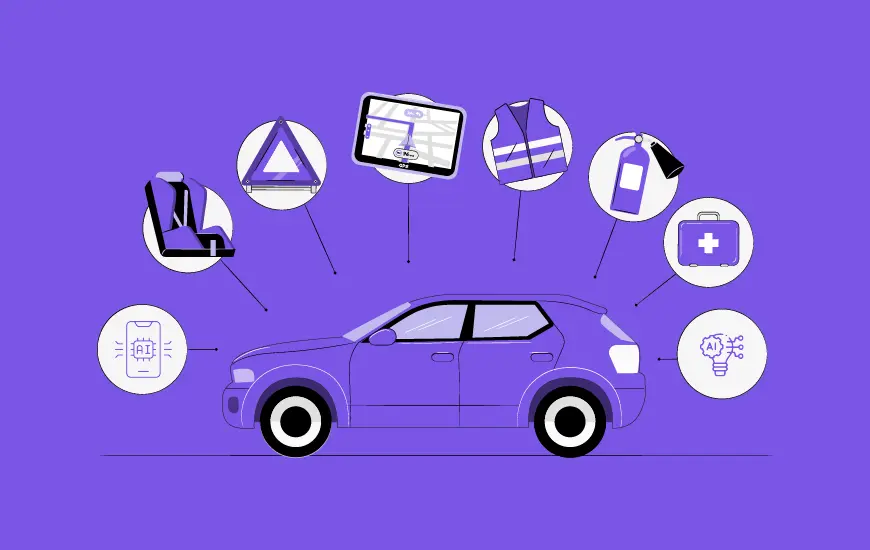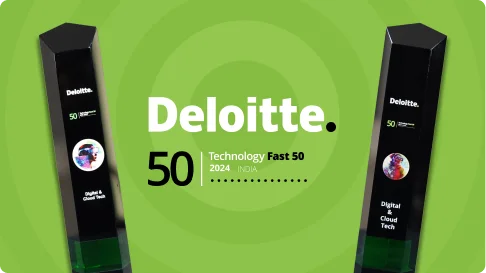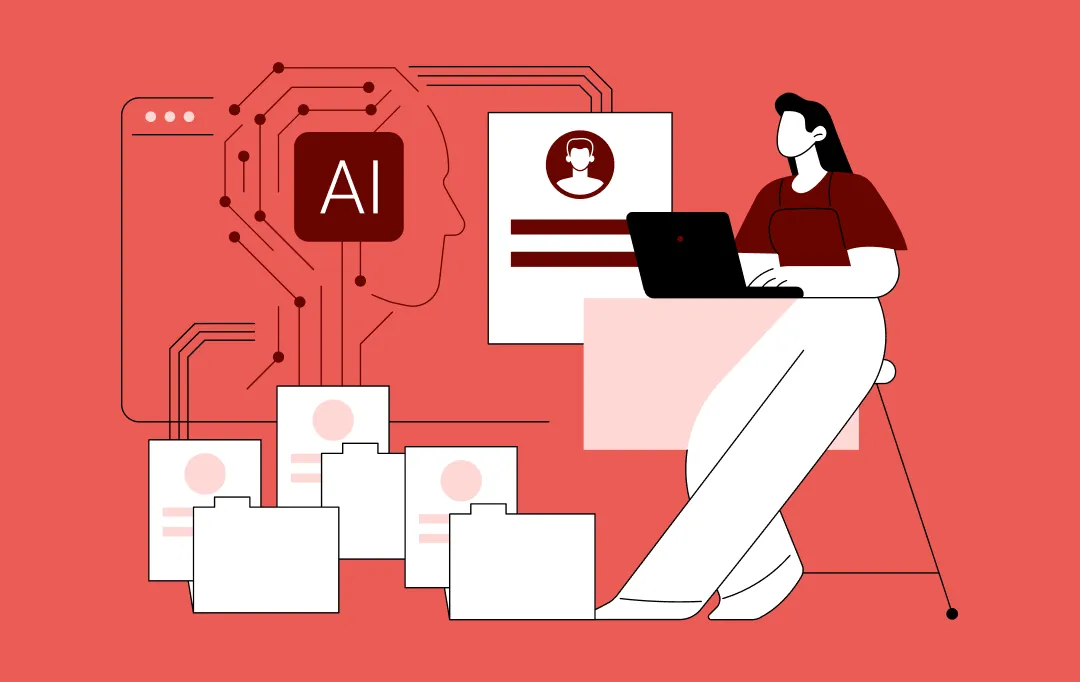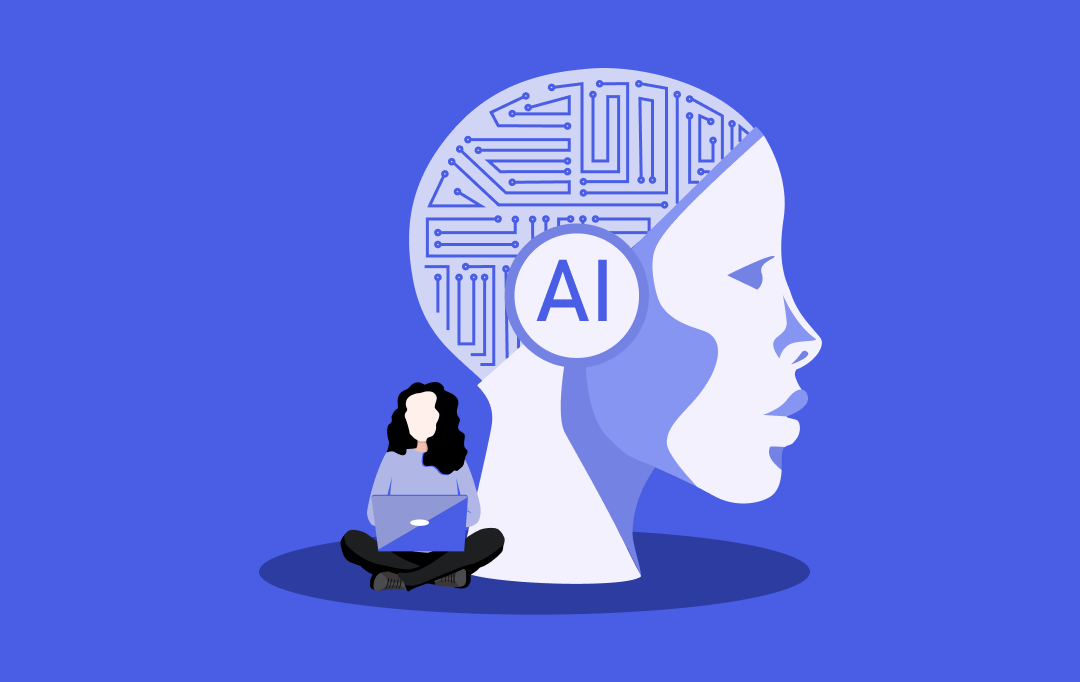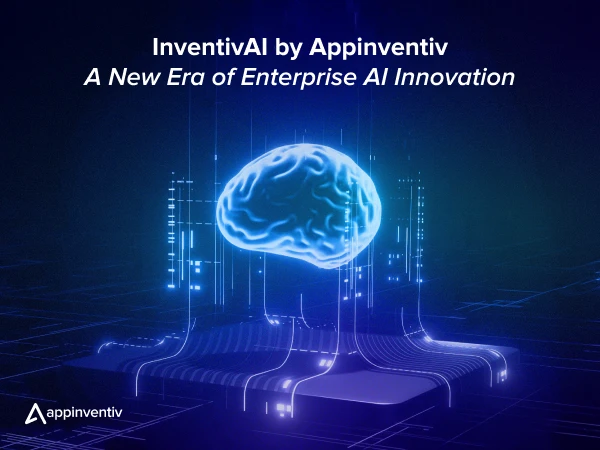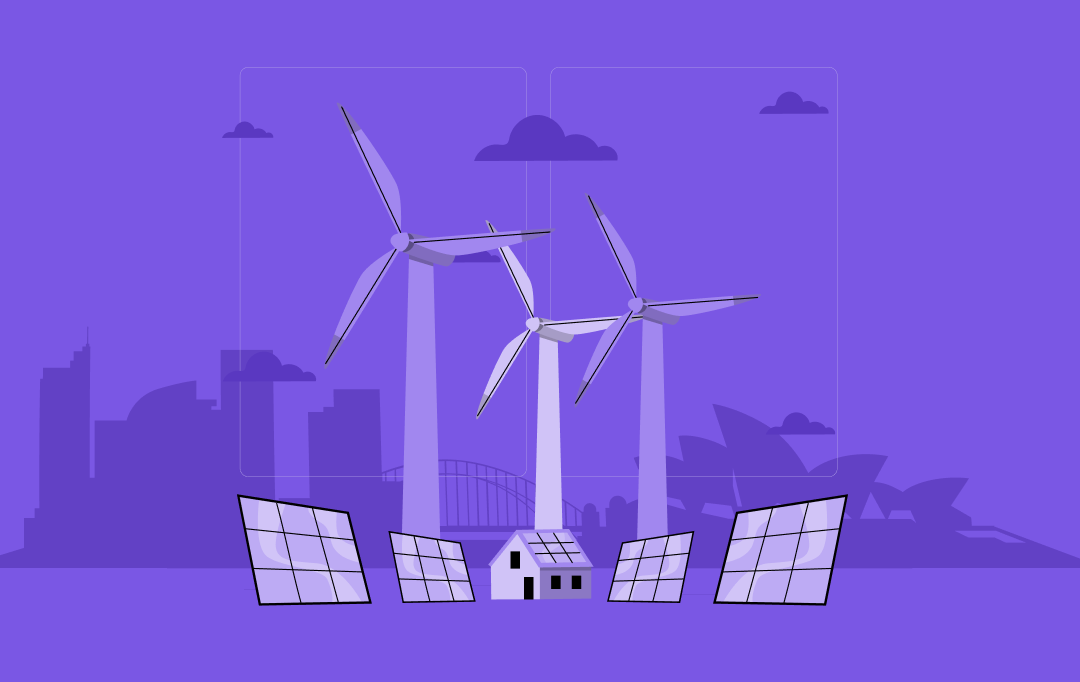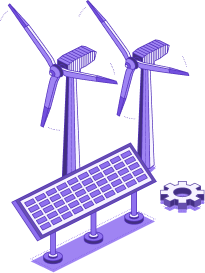- The Intersection of Technology and Renewable Energy
- Enhancing Efficiency
- Scalability Through Digitalization
- Improving Affordability
- Opportunities for Energy Service Providers
- 10 Ways Technologies Shaping the Renewable Energy Industry in Australia
- Advanced Solar Panel Efficiency
- Wind Turbine Optimization with AI
- Energy Storage Breakthroughs (Next-Gen Batteries)
- Smart Grids and IoT Integration
- Hydrogen Production Innovations
- Drone and Robotics Maintenance
- Digital Twins for Project Planning
- Carbon Capture and Utilization Tech
- Blockchain for Energy Trading
- Data Analytics for Energy Forecasting
- Challenges with Technologies and Renewable Energy Integration
- Grid Integration & Stability
- High Upfront Costs
- Cybersecurity Threats
- Regulatory & Policy Barriers
- Supply Chain & Resource Limitations
- The Future of Technology in Renewable Energy in Australia
- Build Custom Renewable Energy Tech Solutions with Appinventiv
- FAQs
Key takeaways:
- Technology is speeding up the process of transformation in Australia towards clean, reliable, and affordable renewable energy.
- Energy systems are becoming smarter and more efficient with the innovations of AI, IoT, advanced batteries, and blockchain.
- The government is contributing to the growth of green hydrogen, smart grids, and large-scale storage through government support and investment.
- Businesses that adopt digital solutions will be able to unlock new opportunities and keep up in the changing energy environment.
- It is crucial to overcome obstacles, including integration, cost, and cybersecurity, to achieve Australia’s clean energy potential
Inovations are reshaping how power is created, stored, and shared, from smart solar panels on rooftops to intelligent energy grids that learn and adapt. Australia is entering an exciting new chapter in its journey toward clean, sustainable energy, and technology in renewable energy in Australia is leading the way.
Australia is home to world-leading research institutions like CSIRO, which has pioneered breakthroughs in solar technology, hydrogen, and energy storage.
With bold national goals like reaching 82% renewable electricity by 2030, it’s clear that the future depends not just on more solar and wind but also on smarter ways to use them. (voanews).
And that’s exactly where technology in renewable energy in Australia steps in.
Use cases of technologies like AI in renewable energy, applications of IoT in renewable energy, advanced battery storage, and even blockchain in the renewable energy industry are solving real challenges and making renewable energy more reliable, affordable, and accessible for everyone.
Whether helping homes track their energy use in real time or improving how wind farms talk to the grid, these tech breakthroughs are quietly powering green energy in Australia. The role of technology for the renewable energy industry in Australia is also evident in how it bridges gaps between energy production and consumption, ensuring a seamless flow of clean power.
In this blog, we’ll explore ten powerful ways technology is reshaping renewable energy in Australia. Whether you’re a clean energy enthusiast, a policymaker, or just curious about how tech makes our future greener, this article will show you the full picture.
The Intersection of Technology and Renewable Energy
The future of renewable energy isn’t just about generating more solar or wind power—it’s about how technology for the renewable energy industry in Australia, including solutions like Renewable Energy Software in Australia, is transforming the entire energy ecosystem. Technology bridges this intersection, connecting clean energy sources with smarter systems, better storage, and real-time data insights. This shift is especially important for Australia, where vast landscapes, strong sunlight, and wind potential offer unique advantages.
Here’s how technology is making a difference:
Enhancing Efficiency
Artificial Intelligence (AI) has revolutionized the optimization of renewable energy systems. AI in the energy sector enables predictive energy generation and usage patterns, making grid management and utilization more efficient. According to a study in the Journal of Energy Engineering, AI-based solutions can greatly enhance the efficiency of renewable energy technologies in Australia, making them cost-effective and reliable.
Scalability Through Digitalization
Digitalizing the National Electricity Market (NEM) in Australia has been instrumental in scaling renewable energy initiatives. Advanced digital platforms enable dynamic energy transactions, allowing real-time adjustments and integrations of various energy sources. The Australian Energy Market Commission (AEMC) notes that digitalization facilitates the seamless incorporation of the renewable energy technology sector into the grid, thereby enhancing scalability.
Improving Affordability
Technological progress has also decreased the price of renewable energy. The economic stimulus partly results from the technology improvements that have reduced the cost of production and operation in the renewable energy sector.
Opportunities for Energy Service Providers
The Australian Renewable Energy Agency (ARENA) plays a pivotal role in funding and accelerating the commercialization of innovative renewable energy solutions, from large-scale battery storage to next-generation grid integration projects.
These technologies are crucial for energy service providers to maximize services and win contracts. The Energy-as-a-Service (EaaS) model, based on harnessing technology, analytics, and tailored services, allows customers to realize maximum energy cost savings. The EaaS model reduces challenges such as the high costs of upfront technologies and uncertainty on performance, helping businesses overcome the challenges with technologies and renewable energy integration and deliver value faster.
Business Growth & Innovation
Businesses that invest in AI, IoT, and blockchain for renewables can offer advanced solutions and secure contracts with energy companies. Such technologies enable companies to streamline operations and forecast energy usage, as well as increase data sharing transparency. Through the adoption of digital technology, companies can become long-term players in the supply chain of renewable energy.
Government Support & Financing
Australia’s green hydrogen investment, smart grid, and energy storage offer capital incentives to firms to adopt new technology for the renewable energy industry in Australia. Besides the financial support, government programs also promote cooperation between the research institutions and the companies. Such a combination of capital and information sharing is used to minimize risk, and it quickens the commercialization of renewable technologies.
Decentralized Energy Markets
Microgrids and peer-to-peer energy trading enable consumers and producers to benefit from blockchain-based models. With these kinds of systems, local energy independence is promoted, as well as transmission losses minimized, and resilience during outages improved. They also provide a means for small producers to earn money and make a more sustainable energy network.
Sustainability & Carbon Credits
Initiatives like Net Zero Australia, which is a collaboration between leading universities, CSIRO, and industry, are mapping out detailed pathways for the nation to achieve its 2050 net-zero emissions goal. Businesses can also get involved through the reduction of emissions, trading carbon credits, and investing in low-carbon technologies. Such programs also enhance corporate image and demonstrate a commitment to achieving global climate goals.
International Leadership
By pioneering future technology for the renewable energy industry in Australia, it has become a global hub for sustainable energy solutions, attracting foreign investment and export opportunities. Australian firms are not only exporting clean energy but also transferring best practices and technological knowledge to other partners around the globe. This leadership position enables influencing international energy policy and establishing stronger trade ties.
10 Ways Technologies Shaping the Renewable Energy Industry in Australia
Australia’s renewable energy landscape isn’t just changing; it’s undergoing a complete tech overhaul. From AI-powered energy grids to new-generation solar panels that absorb sunlight like a shot of espresso, new ideas are boosting sustainability to unprecedented levels. The bulky, wasteful systems era has ended, and the future focuses on more intelligent, quicker, and greener energy solutions.
Be it wind farms enhanced by machine learning or blockchain eliminating intermediaries in energy trading, technology is transforming how Australians power their homes, businesses, and entire cities. Get ready—here are ten ways tech revolutionizes renewable energy in Australia.
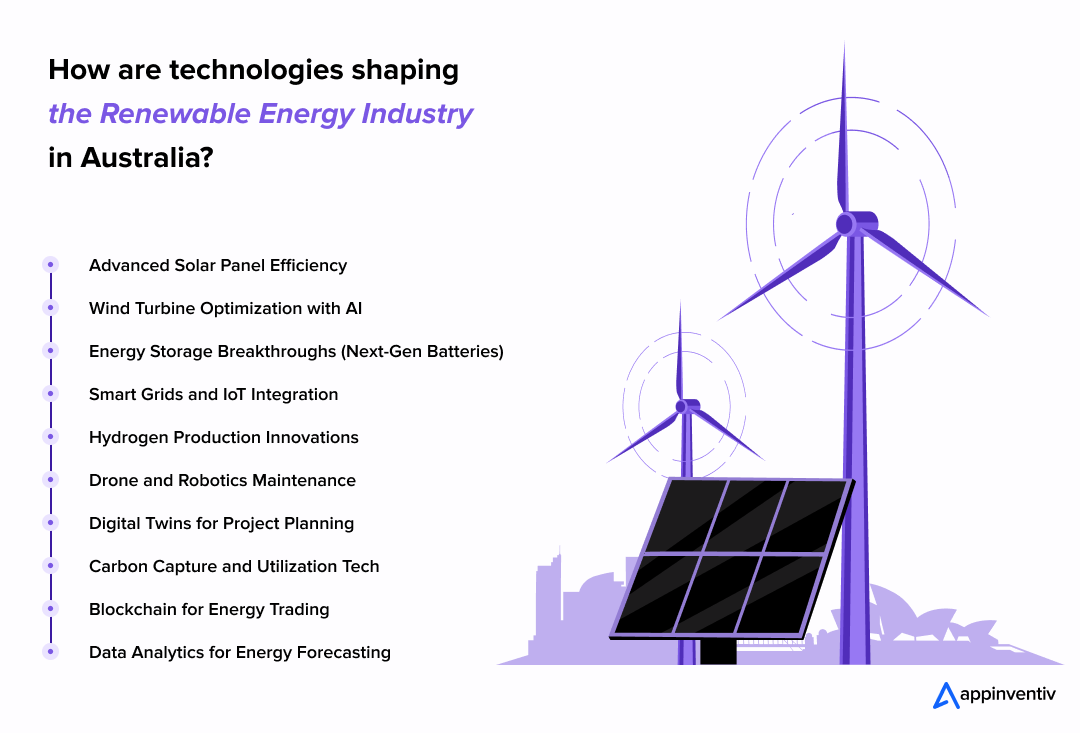
Advanced Solar Panel Efficiency
Solar energy remains the top renewable power source and cutting-edge technology for the renewable energy industry in Australia. Breakthroughs include perovskite solar cells and bifacial panels, which increase the efficiency of solar systems by capturing more light and boosting the energy yield.
Even within Australia, gigantic Queensland and New South Wales solar farms already include these newer technologies. For example, certain projects use bifacial panels that gather light on the front and the rear of the panels to boost efficiency. Further, the research push on perovskite material, which provides better efficiency ratios and lower production costs than silicon-based panels, is leading to further adoption.
This trend allows companies to provide innovative solar installation and maintenance services to commercial and residential customers, integrate the newest renewable energy technologies in Australia, and optimize energy generation.
Wind Turbine Optimization with AI
Artificial Intelligence (AI) transforms wind energy in Australia through improved turbine efficiency and reduced downtime. AI-enabled predictive maintenance enables operators to identify faults ahead of time, conserving operational costs and averting failures that can halt energy production. AI in the energy sector also improves turbine blade design to maximize aerodynamics for efficient energy extraction.
Offshore wind farms near Gippsland in Victoria, Australia, use AI in renewable energy sector to provide maximum efficiency. With AI and ML in renewable energy, such projects can monitor weather patterns and the functioning of the turbines and adjust in real time for maximum efficiency.
This presents a chance for companies to offer AI integration solutions to wind energy companies to improve their turbine efficiency, lower maintenance expenses, and increase the life of their equipment.
Energy Storage Breakthroughs (Next-Gen Batteries)
One of the largest issues with renewable energy is that it is intermittent, as solar and wind depend on the weather. The answer is next-generation energy storage systems, including next-generation lithium-ion and flow batteries, to hold excess energy and disseminate it when necessary.
Australia leads the pack regarding large battery initiatives, and one shining light is South Australia’s Hornsdale Power Reserve. The facility, fueled by Tesla’s cutting-edge lithium-ion batteries, has demonstrated how energy storage can stabilize grids through backup power during peak periods and reduce dependence on fossil fuels.
These organizations can join this movement by launching various new battery solutions, from business energy storage for firms to grid-scale storage to improve energy reliability.
Smart Grids and IoT Integration
The traditional electrical grid is being upgraded to a smart, dynamic infrastructure with Internet of Things (IoT) sensors and real-time data analysis. IoT Energy Management and smart grids ensure energy is distributed more effectively, avoid transmission loss, and offer real-time demand-response applications.
Australian Energy Market Operator (AEMO) is helping to make grids smarter, rolling out advanced metering and automation across the country. This reform makes it possible to have total control of energy supply and demand, improving the grid’s stability overall. IoT smart meters allow real-time consumption data, which allows consumers and businesses to keep track of their consumption and cut their bills.
For technology companies, this is an opportunity to build or keep building smart grid infrastructure and utilities to deploy advanced metering and grid optimization technologies.
Hydrogen Production Innovations
Green AI has significantly solved sustainability challenges and influenced Australia’s green hydrogen revolution. It improves production, storage, and distribution methods. AI uses machine learning to boost electrolysis efficiency, forecast energy needs, and reduce waste. This makes green hydrogen cheaper and easier to scale up.
The Australian government has invested $1.3 billion in hydrogen energy projects in Western Australia. These projects can benefit greatly from AI-driven automation. AI-based predictive analytics help streamline supply chains, and smart grids ensure that renewable energy and technology sources work at their best.
Moreover, Green AI is playing a crucial role in advancing green energy in Australia, helping hydrogen tech companies grow into key players. They can become suppliers, advisors, or builders of infrastructure. AI in renewable energy allows them to watch systems in real time, fix things before they break, and predict energy use. This tech-savvy approach puts Australia at the forefront of green hydrogen and speeds up the country’s shift to sustainable energy.
Drone and Robotics Maintenance
Drone and robot technologies are revolutionizing renewable resource maintenance by lowering costs and increasing efficiency. Solar panels and windmills are today being monitored by drones equipped with high-resolution cameras and thermographic scanners that detect faults automatically without any human operator intervention.
Transgrid and AGL use drone technology to inspect their renewable energy assets, improving uptime and performance. Automated inspection is delivered quicker, more consistently, optimizing asset management and reducing the risk of equipment failure.
Providing drone-based inspection and maintenance services is an appealing business case for service providers because demand for affordable, effective asset monitoring remains on the rise.
Digital Twins for Project Planning
Technology is transforming how renewable energy Australia projects are planned and managed. By creating virtual replicas of real-world energy assets, developers can simulate performance, identify potential risks, fine-tune designs, and improve operational efficiency—all before anything is built.
Digital twin technology is applied to major projects such as Snowy 2.0 to improve engineering designs and simulate how energy assets perform in varying conditions. This reduces errors, saves money, and boosts overall project delivery.
Digital twins in the energy sector can provide valuable services to renewable energy developers to enhance project planning, risk assessment, and operating efficiency.
Carbon Capture and Utilization Tech
Given the pressure on carbon-emitting industries, CCU technology is gaining importance. The technologies capture the CO2 emissions and convert them to useful commodities, such as construction materials or biofuels.
CCU technology is gaining traction among Australian heavy industries interested in switching to cleaner operations. Businesses can use carbon capture technologies in combination with renewable energy to encourage their industrial customers to reduce their carbon footprint and comply with tight environmental laws.
Industrial clients can partner with businesses specializing in creating or providing carbon capture technology, paving the way for a greener and cleaner energy future.
Blockchain for Energy Trading
Blockchain is reshaping the energy sector by transforming the conventional energy trading platform in the renewable energy industry. It facilitates peer-to-peer, decentralized transactions, enabling consumers and businesses to sell and purchase renewable energy directly without middlemen, resulting in cost savings and transparency.
Power Ledger is one of the businesses participating in South Australian and Victorian blockchain pilot programs in Australia, which attest to the technology’s viability for efficient energy transaction management. Through blockchain technology, energy producers can trace and authenticate clean energy usage, allowing for equitable prices and secure transactions.
Enterprises can move into this area by creating blockchain software for energy generators or retailers and enabling frictionless energy trading on decentralized platforms.
Data Analytics for Energy Forecasting
Precise energy prediction is essential to cope with the uncertainty of renewable energy sources such as wind and sunlight. Machine learning programs are being used increasingly to study patterns in weather, energy consumption patterns, and grid activity, enabling operators to predict and control energy supply more effectively.
Analytics balances demand and power supply in the National Electricity Market (NEM) in Australia. With predictive models, energy suppliers can optimize grid efficiency, minimize inefficiencies, and boost energy reliability.
AI analytics platform-providing companies can assist renewable energy Australia firms in making their operations efficient, lowering costs, and providing a stable energy supply.
Challenges with Technologies and Renewable Energy Integration
As technology in renewable energy in Australia takes off, policymakers and corporations face challenges and opportunities. Innovations that integrate these technologies into existing infrastructure drive efficiency and sustainability. However, technical, financial, and regulatory challenges plague this.
Grid Integration & Stability
The inherent volatility of solar and wind power makes achieving grid stability challenging. Though smart grids and storage alleviate this, extensive implementation requires major investment.
Solution: Expanding large-scale battery systems and adopting demand-response programs can balance supply fluctuations and improve resilience.
High Upfront Costs
Advanced technologies such as hydrogen generation, energy forecasting using artificial intelligence, and blockchain energy trading demand significant up-front investment, which hinders widespread adoption.
Solution: Public–private financing models and government subsidies can offset early costs, enabling broader adoption of advanced energy systems.
Cybersecurity Threats
As IoT, AI, and blockchain become increasingly involved in energy management, safeguarding critical infrastructure from cyberattacks becomes a pressing issue.
Solution: Implementing layered cybersecurity frameworks and continuous monitoring can secure digital energy platforms against potential breaches.
Regulatory & Policy Barriers
Australia’s changing energy policies and regulatory requirements affect how quickly renewable energy technologies in Australia can expand across sectors.
Solution: Establishing stable long-term policies and clearer compliance pathways can provide certainty for businesses investing in renewables.
Supply Chain & Resource Limitations
The availability of materials such as lithium, rare earths, and semiconductors can influence how quickly emerging renewable energy technologies in Australia are rolled out.
Solution: Diversifying supply chains, investing in recycling technologies, and developing local resources can reduce dependency on imports.
The Future of Technology in Renewable Energy in Australia
Australia is a world leader in renewable energy technology, with the newest solar, wind, storage, AI, and hydrogen technology. The latest developments in renewable energy trends in Australia will drive efficiency, reliability, and sustainability, establishing the nation as a world clean energy superpower.
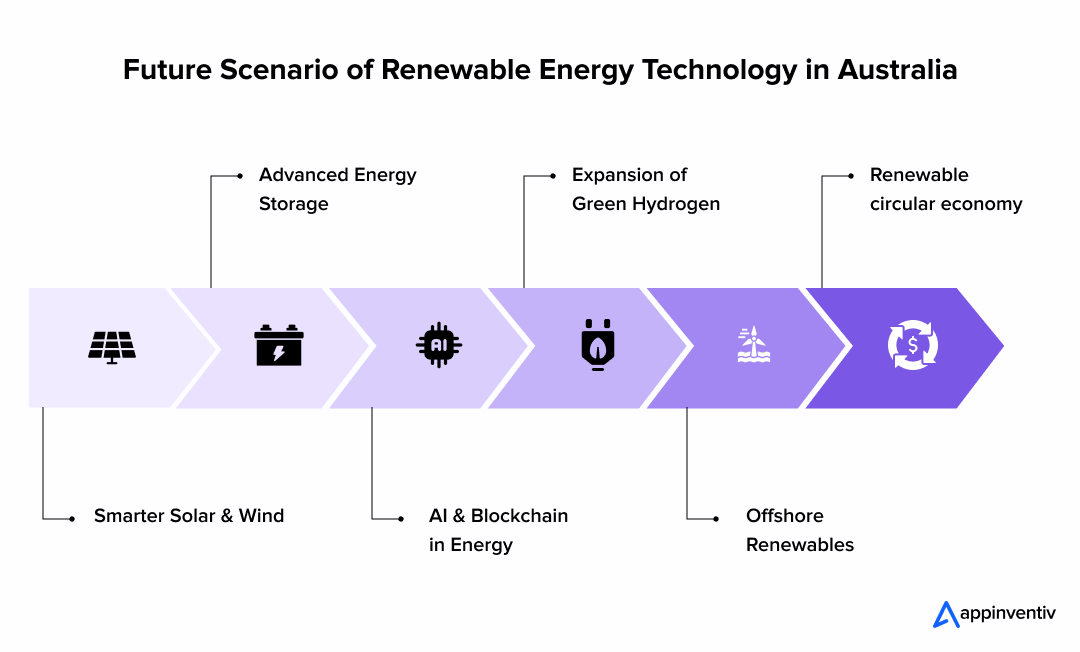
- Smarter Solar & Wind: Advanced next-generation multi-junction solar cells and thin-film panels will become more efficient, and floating wind farms and AI-powered turbine maintenance will extract maximum wind power.
- Advanced Energy Storage: Solid-state batteries, gravity storage, and thermal energy systems will offer more sustainable, long-term energy solutions than lithium-ion batteries.
- AI & blockchain in renewable energy industry: Smart grids and virtual power plants (VPPs) will optimize energy distribution, whereas P2P energy trading through blockchain will allow consumers to buy and sell electricity efficiently.
- Expansion of Green Hydrogen: Low-cost electrolyzers will facilitate mass hydrogen production for power transport and industry, where Australia will become the world leader in hydrogen export.
- Offshore Renewables: Solar farms floating offshore and ocean power schemes will release Australia’s coastal bounty and supply a secure, dependable source of clean energy.
- Renewable circular economy: Recycling solar panels, wind turbine blades, and batteries will establish a closed energy loop with minimized waste and consumption of rare earth minerals.
- Solar Photovoltaics (PV) Development: Solar PV development in Australia has been the strongest with an increasing amount of rooftop solar systems enabling the country to move to a more sustainable energy future.
With rapid advancements in technology for the renewable energy industry in Australia, the country is set to revolutionize the global energy landscape, making sustainable power more efficient and accessible than ever before.
Build Custom Renewable Energy Tech Solutions with Appinventiv
As Australia advances toward a cleaner energy future, the role of smart technology in renewable energy has never been more critical. Technology in renewable energy in Australia is increasingly improving reliability, reducing costs, and meeting growing demand.
However, building these tailored solutions requires more than technical ambition; it demands deep expertise in renewable energy systems, regulatory landscapes, and emerging technologies. That’s where a trusted digital partner like Appinventiv Australia can make a real difference. Our 1600+ tech experts specialize in AI, IoT, and blockchain in renewable energy industry, building tools that support everything from grid optimization to real-time energy monitoring and predictive maintenance.
With bespoke mobile application development services in Australia, we, at Appinventiv, bring years of experience delivering scalable, intelligent, and secure digital products in the energy sector.
So, if you want to build a future-ready technology in renewable energy in Australia, connect with our Aussie experts. We’ll help you design, build, and deploy technology that supports your mission and powers a more sustainable tomorrow.
FAQs
Q. What are the newest developments in solar photovoltaic technology?
A. Developments like perovskite solar cells and bifacial panels greatly enhance solar energy efficiency. In addition, floating solar farms are also being researched to use maximum space and produce more energy.
Q. How is wind power changing with new technology?
A. AI-optimized turbines and offshore wind farms, like those off the Gippsland coast, boost energy production, cut maintenance expenses, and reduce downtime.
Q. What are the latest developments in renewable energy technology?
A. The latest developments in renewable energy technology Australia include AI-powered wind turbine optimization, perovskite solar cells, blockchain for energy trading, and next-gen battery storage solutions.
Q. What is the role of batteries in energy storage and grid stability?
A. Improvements in lithium-ion and flow battery technologies are guaranteeing better energy storage solutions. Developments such as the Hornsdale Power Reserve extension are assisting in stabilizing the grid by effectively managing renewable energy supply and demand.
Q. How is the role of technology in renewable energy in Australia evolving?
A. The role of technology in renewable energy in Australia continues to expand with advancements in AI-driven efficiency, next-gen batteries, and hydrogen production, making clean energy more reliable and scalable.
Q. How do smart grids improve energy distribution and management?
A. IoT-enabled smart grids use real-time data analytics to optimize energy distribution, balance demand, and reduce reliance on centralized power sources, ultimately enhancing energy efficiency for consumers and providers.
Q. What is the potential of hydrogen as a renewable energy source?
A. Green hydrogen production, powered by renewable energy, is gaining momentum in Australia, with government-backed investments fueling its role in industrial applications and clean energy transitions. Additionally, the application of AI in renewable energy is enhancing efficiency and optimizing production processes, further driving innovation in green hydrogen and other renewable energy solutions.
Q. How is the marine energy in Australia being applied?
A. Wave and tidal energy development in areas such as Western Australia and Tasmania is tapping into the power of oceans, offering renewable energy sources to coastal industries and communities.
Q. What are the risks & solutions of integrating technologies in renewable energy?
A. Key risks include high costs, cybersecurity threats, and grid instability. Solutions involve advanced storage, strong cybersecurity, smart grids, and supportive policies.
Q. In what ways are AI and machine learning changing energy systems?
A. AI is optimizing energy efficiency via predictive maintenance, load balancing, and grid management, reducing outages and optimizing energy distribution.
Q. How is technology reshaping renewable energy in Australia?
A. Technology enhances efficiency, scalability, and sustainability in Australia’s renewable energy sector. AI-driven forecasting, IoT-powered smart grids, and blockchain-based energy trading are optimizing production and distribution. These innovations reduce costs, improve reliability, and accelerate the transition to a cleaner energy future.
Q. How much renewable energy does Australia use?
A. By 2024, renewable energy made up 36% of Australia’s total power production, which broke all previous records. Solar came out on top with 18%, wind followed at 12%, and hydro contributed 5%. The National Electricity Market saw something unprecedented during the December 2024 quarter, with renewables hitting 46% of the mix. Solar power reached a major milestone in October 2024 when it supplied a quarter of what the entire country needed for electricity (Source: Australian Energy Statistics)


- In just 2 mins you will get a response
- Your idea is 100% protected by our Non Disclosure Agreement.

How To Build A Product Scanner App Like Yuka – Explore Features, Cost, Case Studies
Key takeaways: A basic Yuka-style product scanner costs between $40,000 and $80,000, while advanced builds with AI and large databases can reach $400,000 or more. The real work is not scanning barcodes, but managing accurate ingredient data, scoring logic, and compliance with FDA and CCPA rules in the US. Successful apps begin with core features…

How Much Does It Cost to Build a Ticket Booking App like Ticketmaster?
Key takeaways: You'll need anywhere from $40,000 for a basic MVP to over $400,000 for an enterprise-grade solution if you're looking to build an app like Ticketmaster. Want interactive seat maps? Maybe AI recommendations? These features are great, but they'll definitely push your costs up. Here's where you can save some money. Asian developers charge…

Unlocking the Cost of Building a Community Platform Like Qatar Living: What to Expect
Key takeaways: Building a community platform is a business decision first and a technology project second. A strong MVP in Qatar typically starts around QAR 109,200–QAR 254,800, while full-scale platforms move into the QAR 2,184,000+ range based on scale and ambition. Success comes from solving daily user problems, not from copying features. Cost is driven…








